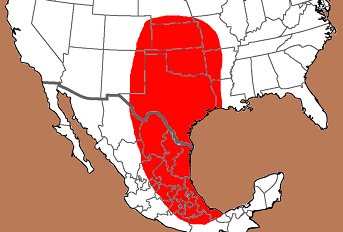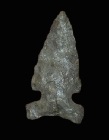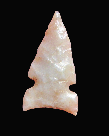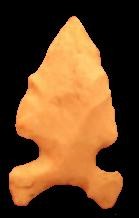Outline is Representative of Size and Shape:

Name Details:
Identified By: James Brown
Named For:
Date Identified: 1968
Type Site: Spiro Mounds, Oklahoma
Identified By: James Brown
Named For:
Date Identified: 1968
Type Site: Spiro Mounds, Oklahoma
Point Validity:
Valid type
Brown is a prominent anthropologist and professor at Northwestern University who has conducted extensive studies at the Spiro Mounds in Oklahoma. This type was named in a professional publication and has limited professional references, possibly due to the small number of examples found. This is considered a valid type.
Haskell Side Notch
Cluster: Washita Cluster Description of Physical Characteristics and Flaking Pattern:
This is a thin small to point with a flattened cross section. The blade is primarily straight to slightly excurvate and may be serrated. Rarely is the blade notched on this point. This point has parallel notches with horizontal shoulders with an expanded stem. The base is most commonly concaved, but some examples may have a straight base. This point commonly has incomplete flaking leaving the surface of the original flake forming a random flaking pattern.
Size Measurements:
Total Length - 15 to 35 mm, Stem Length - 8 to 11 mm, Width at Shoulders - 8 to 15, Neck Width - 5 to 10 mm, Notch Depth - 2 to 3 mm, Notch Placement - 1/4 to 1/2 from the base (based on total length), Basal Width - 12 to 20 mm (Suhm and Krieger, 1954).
Total Length - 15 to 35 mm, Stem Length - 8 to 11 mm, Width at Shoulders - 8 to 15, Neck Width - 5 to 10 mm, Notch Depth - 2 to 3 mm, Notch Placement - 1/4 to 1/2 from the base (based on total length), Basal Width - 12 to 20 mm (Suhm and Krieger, 1954).
Commonly Utilized Material:
Additional Comments:
A key difference between this type and the Harrell is the base. This point has a concave base while the Harrell has a center notch on the base. This type is similar to the Reed point, but this point has a concave base while the Reed point has a straight base. Similar to Toyah points, but differ in the placement of the notches. Toyah points have notches that enter the blade higher on the preform while this point has notches that are lower.
The points in this cluster are similar to the points in the Woodland/Mississippian triangular cluster, except these points have side notches (Morrow, 1984). Both types of points are noted for being thin and in the shape of an isosceles or equilateral triangle. Points in this cluster are noted for a single or multiple parallel notches in the blade. The blade may be serrated for points in this cluster (W2).
A key difference between this type and the Harrell is the base. This point has a concave base while the Harrell has a center notch on the base. This type is similar to the Reed point, but this point has a concave base while the Reed point has a straight base. Similar to Toyah points, but differ in the placement of the notches. Toyah points have notches that enter the blade higher on the preform while this point has notches that are lower.
The points in this cluster are similar to the points in the Woodland/Mississippian triangular cluster, except these points have side notches (Morrow, 1984). Both types of points are noted for being thin and in the shape of an isosceles or equilateral triangle. Points in this cluster are noted for a single or multiple parallel notches in the blade. The blade may be serrated for points in this cluster (W2).
Distribution:

Distribution Comments:
This point are primarily associated with the Caddoan culture and subcultures of Texas, Oklahoma, and into Kansas, Missouri, Arkansas, and Louisiana and into Mexico. These point may be found into adjacent regions with decreased frequency. Points outside the Caddoan cultural territory may fall into one of the Plains Side Notch types. Points found into the Pueblo Cultural and sub culture territories may fall into the Pueblo Side Notch type.
This point are primarily associated with the Caddoan culture and subcultures of Texas, Oklahoma, and into Kansas, Missouri, Arkansas, and Louisiana and into Mexico. These point may be found into adjacent regions with decreased frequency. Points outside the Caddoan cultural territory may fall into one of the Plains Side Notch types. Points found into the Pueblo Cultural and sub culture territories may fall into the Pueblo Side Notch type.
Age / Periods:
Date: 800 - 600 B.P.
Cultural Period: Mississippian
Glacial Period: Medieval Warm
Culture: Caddoan Culture
Date: 800 - 600 B.P.
Cultural Period: Mississippian
Glacial Period: Medieval Warm
Culture: Caddoan Culture
Age Details:
Similar Points:
Edwards, Harrell, Huffaker, Little Sioux, Plains, Prairie, Reed, Teotihuacan, Toyah, Washita
Edwards, Harrell, Huffaker, Little Sioux, Plains, Prairie, Reed, Teotihuacan, Toyah, Washita
Other points in this cluster / Related / Associated Points:
Cahokia, Des Moines, Harrell, Haskell, Huffaker, Reed, Washita, Washita Peno
Cahokia, Des Moines, Harrell, Haskell, Huffaker, Reed, Washita, Washita Peno






